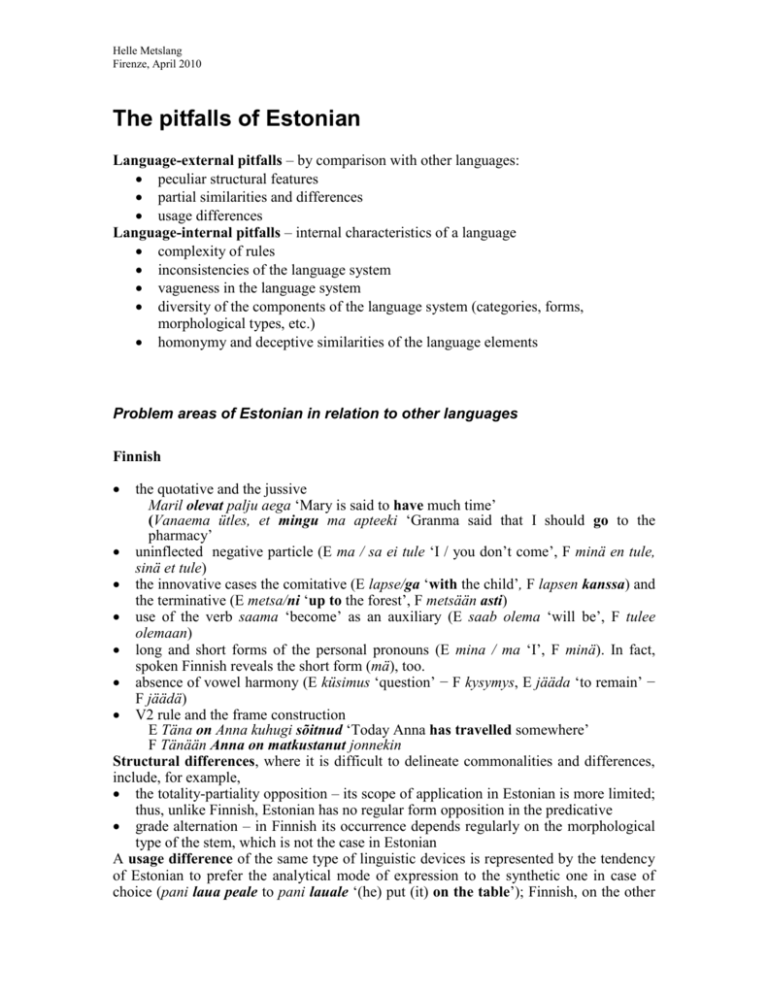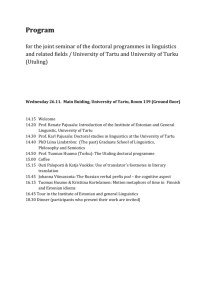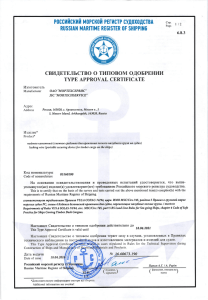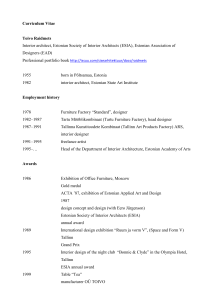DIE ”HAKEN” DES ESTNISCHEN
advertisement

Helle Metslang Firenze, April 2010 The pitfalls of Estonian Language-external pitfalls – by comparison with other languages: peculiar structural features partial similarities and differences usage differences Language-internal pitfalls – internal characteristics of a language complexity of rules inconsistencies of the language system vagueness in the language system diversity of the components of the language system (categories, forms, morphological types, etc.) homonymy and deceptive similarities of the language elements Problem areas of Estonian in relation to other languages Finnish the quotative and the jussive Maril olevat palju aega ‘Mary is said to have much time’ (Vanaema ütles, et mingu ma apteeki ‘Granma said that I should go to the pharmacy’ uninflected negative particle (E ma / sa ei tule ‘I / you don’t come’, F minä en tule, sinä et tule) the innovative cases the comitative (E lapse/ga ‘with the child’, F lapsen kanssa) and the terminative (E metsa/ni ‘up to the forest’, F metsään asti) use of the verb saama ‘become’ as an auxiliary (E saab olema ‘will be’, F tulee olemaan) long and short forms of the personal pronouns (E mina / ma ‘I’, F minä). In fact, spoken Finnish reveals the short form (mä), too. absence of vowel harmony (E küsimus ‘question’ − F kysymys, E jääda ‘to remain’ − F jäädä) V2 rule and the frame construction E Täna on Anna kuhugi sõitnud ‘Today Anna has travelled somewhere’ F Tänään Anna on matkustanut jonnekin Structural differences, where it is difficult to delineate commonalities and differences, include, for example, the totality-partiality opposition – its scope of application in Estonian is more limited; thus, unlike Finnish, Estonian has no regular form opposition in the predicative grade alternation – in Finnish its occurrence depends regularly on the morphological type of the stem, which is not the case in Estonian A usage difference of the same type of linguistic devices is represented by the tendency of Estonian to prefer the analytical mode of expression to the synthetic one in case of choice (pani laua peale to pani lauale ‘(he) put (it) on the table’); Finnish, on the other hand, prefers the synthetic mode (pani pöydälle). Estonian uses non-finite constructions and the essive less frequently. Russian existence of the perfect (on loonud ‘has created’) and the past perfect (oli loonud ‘had created’); Russian has only the imperfect (sozdal ‘he created’), and compound forms are represented by the passive past perfect construction (byl sozdan ‘was created’) existence of a separate impersonal form (loetakse ‘is read’); in Russian impersonality is expressed by the third person plural form in the active (čitajut ‘(they) read’) grammatical expression of evidentiality use of the present-tense forms of the verb olema ‘to be’ (in Russian they are generally omitted) existence of two main infinitives (E luge/ma, luge/da ‘to read’ − R čita/t’) absence of grammatical gender and the future expression of aspect by means of morphological alternation of the object (in Russian aspect is regularly expressed by means of verb derivation, e.g. čitat’ ‘to read’ : pro/čitat’ ‘to read through’, vy/pit’ ‘drink’ : vy/pi/va/t’) agreement in person in the imperfect (in Russian the predicate agrees in person and number in the present but in gender and number in the past, e.g. on čita/l ‘he read’, ona čita/la ‘she read’, oni čita/li ‘they read’) in the area of word order V2 rule, the frame construction, preposed genitive attribute (E poisi raamat ‘the boy’s book’ − R kniga mal’čika) the long and the short forms of the personal pronoun grade alternation and other stem alternations. In fact, stem alternations occur in Russian, too, but their nature and rules are different. Partial similarities, where the delineation of similarities and differences may pose problems, include, for example, case alternation of the subject in the existential sentence. Both in Estonian and Russian the case of the subject changes in the negative existential sentence – in Estonian it is in the partitive while Russian uses the genitive. E Laual on raamat (sgN) ‘There is a book on the table’ E Laual ei ole raamatut (sgP)‘There is no book on the table’ R Na stole kniga (sgN) ‘There is a book on the table’ R Na stole net knigi (sgG) ‘There is no book on the table’ Unlike the Russian language, in Estonian the partitive subject can occur also in the affirmative existential sentence: Laual on raamatuid ‘There are some books on the table’ Choice of the case of the object. In Russian, too, the object may occur in several forms but the circumstances that direct the choice of the form are different (lexical classes, gender, number) E Loe romaan (sgN) läbi! ‘Read the novel through!’ R Mal’čik čital roman (sgAcc=sgN) ‘The boy read the novel’ number of the numeral that modifies a noun – in Estonian it is the partitive singular for all the numerals starting with two; in Russian the genitive singular is used for 2, 3, and 4 while in the case of larger numbers the genitive plural is used. restricted use of the future constructions. Russian has regular grammaticalized analytical future tense 2 A usage difference is, for example, lesser emotionality of Estonian speech, which explains less frequent use of diminuatives. German expression of sentential negation always occurs in the predicate: E Mul ei ole raamatut ‘I don’t have the book’ D Ich habe kein Buch there are separate participles for the active (E elanud ‘lived’) and the passive (E elatud ‘lived’); German has a single participle (gelebt) existence of two infinitives (E elama, elada ‘to live’ − D leben) absence of grammatical gender and articles multiple forms of the predicative : Peeter oli õpetaja ‘Peeter was a teacher’ Peeter oli külakoolis õpetajaks ‘Peeter used to be a teacher at a village school’ long and short personal pronouns morphological opposition of totality-partiality, expression of aspect by means of the object intransitive possessive clause Mul on raamat ‘I have a book’ (lit. ‘by me is a book’) Ich habe ein Buch form of the noun that modifies the numeral – in Estonian it is the partitive singular (sada raamatut ‘a hundred books’) while German uses the nominative plural (hundert Bücher) grade alternation and other stem alternations Some of the similarities between Estonian and German that may pose problems with regard to the extent of similarity include, for example, evidential use of the Estonian quotative and the present conjunctive in German Maril olevat palju aega Mari habe viel Zeit ‘Mari is said to have much time’ use of the verb saama ‘to get, to become’ as an auxiliary auxiliary verb in compound tenses: olema ’to be’ is the only one in Estonian while a second-level auxiliary in German particle verbs have spread in Estonian with the support of German and reveal partial correspondences with it (Hasselblatt 1990): üles otsima – aufsuchen ‘to seek out’, sisse tegema – einmachen ‘to bottle’, however, it need not be the case always, e.g. üles sulama ‘to melt’ – schmelzen. the object in the nominative – in German, too the accusative can take the shape of the nominative depending on the lexical class of the word (er las das Buch) word order – Estonian reveals a tendency to the V2 rule and the frame construction; German, however, has somewhat stricter rules. Usage differences include, for example, use of the Estonian perfect in the meaning of the compound tense; one can find it in spoken German in the meaning of the simple past person of the politeness form (Estonian teie ‘you’, German Sie ‘they’) 3 Internal pitfalls of Estonian Complexity of rules (e.g. case of the object and the subject) Inconsistencies in the language system (variation / stability of the word stems and components, different declension of similar nouns, congruence / incongruence in constructions) Vagueness in the language system (e.g. absence of clear morpheme boundaries in inflecting forms) Diversity in the components of the language system (e.g. case, non-finite verb forms, conjugation and declension types) Lexical and grammatical homonymy: similarities in the grammatical forms and morphemes , diversity in the functions of function words Deceptive differences: synonymy, constructions with the identical meaning A selection of problem areas in Estonian (Metslang et al. 2003) Vocabulary, word-formation Lexical homonymy full root homonymy: hari : harja (1. ´brush’, 2. ‘crest’), cf. Fi. harja : harjan partial root homonymy: härm : härmi (’discontent’) – härm : härma (’hoar-frost’; ’spider’s web’, dial. ’spider’, ’net’), Fi. harmi - härmä; koor : koore (’(sour) cream; peel;; shell’) – koor : koori (’choir’), Fi. kuori – kuoro; homography: kruus : kruusa ’gravel’ – kruus : kruusi ’mug’ (s being palatalized before i) derivative homonymy: nimi nimetu nimetus ’name’ → ’nameless’ → ’namelessness’ nimi nimetama nimetus ’name’ → ’to name’ → ’name, designation’ Fi. nimi nimetön nimettömyys; nimi nimittää nimitys Morphology Diversity of the components of the language system Case (14) Non-finite verb forms (EKKR: ca 20 ) Declension types (EKKR: 40–50 ) Conjugation types (EKKR: 25–30) Inconsistencies in the language system des: similar base forms, different inflections nominative – genitive 4 kõne : kõne ’speech’, pere : pere ’family’ – säde : sädeme ’spark’, tore : toreda ’nice’ koni : koni ’stub’ – uni : une ’sleep’ Fi rivi : riven ‘row’, uni : unen, but kori : korin lagi : lae ’ceiling’ – nagi : nagi ’coat rack’ Fi laki : lain ’law’; but: muki : mukin ’mug’ roog : roa ’dish’ – roog : roo ’reed’ Fi ruoka, ruoko partial homonymy: koor, -i – koor, -e Different base forms, similar inflections nominative – genitive kõne : kõne – uni : une sugu : soo ’sex’ – roog : roo - soo : soo ’swamp’ tigu : teo ’snail’ – tegu : teo ’deed’ magu : mao ’stomach’ – madu : mao ’snake’ Fi. maku : maun ’taste’ – mato : madon ’worm’ jõgi : jõe ’river’ – tõsi : tõe ’truth’ Fi. joki : joen., tosi : toden What is the meaning of sood, teod, maod? (PlN = SgG + d, e.g.. teater : teatri → teatrid) Essay topic Inimesed ja teod Homonymy of declension forms forms of a word SgN – SgG: koi : koi ’moth’, aasta : aasta ’year’ SgN – SgG – SgP: pesa : pesa : pesa ’nest’ Fi. pesä : pesän : pesää SgP – SgIll: kappi : kappi ’cabinet’ Fi. kaappia : kaappiin SgP – PlN pead : pead ’head’ Fi. päätä : päät SgN – PlN: jõud : jõud ’force’ SgN – PlP: käsi : käsi ’hand’ Fi. käsi : käsiä Fi. homonymy: SgP –PlP piitä ’tooth’; SgN – SgG - PlN kirja/nsa ‘one’s book, one’s books’ identical forms of different words SgG: teo (tigu / tegu), soo (sugu / soo) SgP: lihast (lihas ’muscle’ / lihane ’real, one’s own’) Fi. Muhosta (Muhos, Muhonen) 5 säkeistä patoihin (Laalo 1990) säe : säkeen ‘verse’ säkki : säkin ‘sack’ pata : padan ‘pot’ pato : padon ‘dam’ different forms of different words SgEl piprast (pipar : pipra ’pepper’) – SgP piprast (piprane : piprase ’peppery’) Homonymy of conjugation forms forms of a word 2Sg, 3Pl imperfect elasid (’you lived’, ’they lived’), tegid (’you made’, ’they made’) 2Sg, 3 Pl conditional: elaksid, teeksid da-infinitive and impersonal: hakata ’begin’ – ei hakata ’is not begun’ Fi. present – imperfect voin ’can’, luennoin ‘to hold a lecture’ identical forms of different words 3Sg imperfect: küttis (kütma ’to heat’, küttima ’to hunt’) imperfect impersonal: kaevati (kaevama ’to dig’, kaebama ’to complain’) different forms of different words teataks: conditional impersonal of teadma ’to know’ – conditional personal of teatama ’to notify’ Homonymy of declension and conjugation forms: lood: PlN of lugu : loo ’story’ and Sg2 of looma ’to create’ tunnete: PlG of tunne ’feeling’ and Pl2 of tundma ’to feel’ filmiks: translative of film ’film’ and conditional of filmima ’to film’ kaaludes: gerund of kaaluma ’to weigh’ and PL:IN of kaal ’scales’ Fi. kuvaa: P of kuva ’picture’ and imperative of kuvata ’to depict’ Identical or similar word components -ta, -ta-: 1) causative verb suffix: kulu/ta/ma ’to spend’ 2) impersonal: ei võe/ta ’is not taken’ 3) da-infinitive: haka/ta ’to begin’ 4) abessive: võtme/ta ’without a key’ 5) part of the root: vaata/ma ’to look’, vaata ’look’. – Homonymy: soovitama ’to recommend’: soovita ’recommend’; soovima ’to wish’ – ei soovita ’does not wish’; soov ’a request’: soovita ’without a request’ 6 -d: 1) plural suffix of nouns: maja/d ‘houses’ 2) partitive ending of some word types: mer/d ‘sea’ (P)’ 3) ending of the 2nd person singular: tööta/d ‚‘you work’, töötasi/d ‘you worked’ 4) ending of the 3rd person plural in the indicative imperfect and conditional plural: töötasi/d ‘(they) worked’, töötaksi/d ‘(they) would work’ Homonymy: teed 1) tee ‘road / tea’ PLN, 2) tee SGP, 3) tegema ‘do; make’: (you) make’ – doubling: kirju/ta/ta/kse ’is written’ – deceptive similarity: -ks conditional, translative, -kse impersonal: võtaks ’would take’, võetaks ’would be taken’, võetakse ’are taken’ Fi. ottaisi, otettaisiin, otetaan. Syntax Prepositions and Postpositions The same word as a preposition and postposition Ema läks lapsega koos poodi Maja ümber jooksevad lapsed Ema läks koos lapsega poodi Lapsed jooksevad ümber maja ’Mother went to the shop with the child’ ’The children are running around the house’ Different government / meanings of a preposition or postposition läbi: Tee viis läbi (PP) metsa (genitive) ’The path went through the forest’ Vihma sajab aasta (nominative) läbi ’It rains all year long’ eest: Buss sõidab ülikooli (genitive) eest (PP) mööda ’The bus passes by in front of the University’ Ostsin krooni (genitive) eest vihiku ’I bought a copybook for a kroon’ pärast: Pärast (PP) haigust (partitive) oli laps nõrk ’After the illness the child was weak’ Buss väljub poole tunni (genitive) pärast ’The bus leaves in half an hour’ Puudusin haiguse (genitive) pärast ’I was absent because of illness’ Ta väriseb külma (genitive) pärast’He is shivering with cold’ Ema muretseb lapse (genitive) pärast ’Mother is worried aboud her child’ 7 The same word as an adposition and verb particle Similar meanings: Auto sõitis üle (PP) silla (genitiv) ’The car crossed the bridge’ Auto sõitis sillast üle (VP) Different meanings Pall veeres voodi alla ’The ball rolled under the bed’ Auto sõitis mööda tänavat ’The car moved along the street’ Pall veeres voodist alla ’The ball rolled down from the bed’ Auto sõitis õigest tänavast mööda ’The car passed the right street’ Concord Construction adjective attribute + noun (Number, Case) apposition + noun (number, case) subject + predicate (number, person) subject + predicative (number) numeral construction (case) Example suure/s metsa/s ’in a big forest’, suur/te/s metsa/de/s ’in big forests’ Exceptions and special cases ninataga-rule: suure metsa/ni, suur/te metsa/de/ga undecinable adjectives and past participles: katoliku ’Catholic’, oma ’one’s own’, kogu ’entire’, makstud ’paid’: katoliku kiriku/st ’from the Catholic church’, makstud kauba/st ’from the paid merchandise’ venna/d Tamme/d ’the Tamm professor Tamme/le ’to Professor Tamm’; onu brothers’; Peetri/le ’to Uncle Peeter’ ; kohviku/s Tallinn – Peetri/le, kirjaniku/le ’to Peeter, kohvik Tallinna/s ’at the Café Tallinn’ the writer’ mei/d kui lapsevanema/i/d ’us as parents’ ma loe/n ’I read’, poisi/d Ta/nad on ’s/he is, they are’, ei loe (’I do not read, loe/vad ’boys read’, you…’ etc. – negative of all the persons) , ei poisi/d oli/d lugenud ’boys had lugenud (’did not read – negative of all the read ’ persons), lugevat (’is said to read, etc. – quotative of all the persons) Maja on punane ’The house is Teie olete haige ’You are ill’ red’ Majad värviti punaseks ‘ The houses were painted Maja/d on punase/d ’The red’ houses are red’ kahekümne viie ’25’ (genitive), semantic case forms: kahtkümmen/d vii/t ’25’ kahekümne viie/le ’25’ (allative), kahekümne viie/st (partitive) ’25’ (elative) The majority of exceptions and special cases in concord are not to be found in Finnish. 8 To conclude: The language-internal complexities of Estonian include the abundance of morphology and morphological types, inconsistencies and uncertainties in the language system, grammatical homonymy, deceptive similarities, and some complicated grammar rules. However, each background language gives rise to different problem areas. For example, in the case of Finnish they include analytical mode of expression and word order, in the case of Russian it is the case alternation of the object and agreement, in the case of German it is the case alternation of the object and use of the perfect. The extent of similarities calls for delineation first and foremost for Finnish but also for German. References EKKR = Erelt, Mati & Tiiu Erelt, Kristiina Ross 2000, Eesti keele käsiraamat. Tallinn: Eesti Keele Sihtasutus. Hasselblatt, Cornelius 1990, Das estnische Partikelverb als Lehnübersetzung aus dem Deutschen. (Veröffentlichungen der Societas Uralo-Altaica 31.) Wiesbaden: Harrassowitz. Hasselblatt, Cornelius 1993, Estnisch, Finnisch und Ungarisch: zur Bewertung der Schwierigkeiten für deutsche Muttersprachler. – Linguistica Uralica XXIX, 3: 176 – 181. Kasik, Reet 1992, Suomen ja viron sananjohdon vertailua. - Viron kielen päivä 6.5.1992. Toim. H. Sulkala ja V.-L. Kingisepp. (Oulun yliopiston suomen ja saamen kielen laitoksen tutkimusraportteja 35.) Oulu. Laalo, Klaus 1990, Säkeistä patoihin: suomen kielen monitulkintaiset sananmuodot. (Suomi 154.) Helsinki : Suomalaisen Kirjallisuuden Seura Metslang, Helle & Ingrid Krall, Renate Pajusalu, Kristi Saarso, Elle Sõrmus, Silvi Vare 2003, Keelehärm. Eesti keele probleemseid piirkondi. Tallinn. Metslang, Helle 2004, Eesti keele keerukohti. – Virsu II. Suomi ja viro kohdekielinä. Lähivertailuja 15. (Oulun yliopisto, suomen ja saamen kielen ja logopedian laitoksen julkaisuja 24.) Toim. H. Sulkala ja H. Laanekask. Oulu: 71-82. Metslang, Helle (to appear), The pitfalls of a language: Estonian as L2. – Bilinguisme et traduction. Paris: L’Harmattan Miestamo, Matti 2006, On the feasibility of complexity metrics. – FinEst Linguistics. Ed. by Krista Kerge & Maria-Maren Sepper. Tallinn: Tallinn University Press: 11-26. 9 Kuidas eristada „koort“ „koorist“?! Eristada neid on väga kerge. Esimest on võimalik osta poest ja ta maksab 5 krooni poole kilo eest. Teist sõna „koor“ kauplusest ei saa osta. Näiteks lastekoori on võimalik tellida spetsiaalsetest kohtadest ja siis nad hakkavad laulma teie jaoks. Veel on suur vahe nende vahel selline, et esimest „koort“ on võimalik süüa, aga teist mitte. Kui sina tahaks süüa teist siis sul võib hakata hirmus, sest lastekoor ei tahaks olla ära söödud. Esimeses „koores“ on palju valku, teises on palju liha. Esimene koor ei saa olla külmkapita, teine ei saa esineda dirigendita! Esimest me võime suppi panna, teist aga ei saa, sest ta hakkab vastu karjuma. „Koor“, mida me sööme, on alati valge, „koor“ mida me kuulame, on alati värviline. Mõnikord on nii, et koorepakk on ilus ja lastekoor laulab ilusasti. Siis nad sarnanevad teineteisega, kuigi esimene „koor“ näeb välja ilus, teine aga kõlab ilusasti... Esimine „koor“ Teine „koor“ Wie ist koor ‘Sahne’ von koor ‘Chor’ zu unterscheiden? (Internetfolklore von russischen Kindern im Gebiet Virumaa) Es ist sehr leicht, sie zu unterscheiden. Die erste kann man im Laden kaufen und sie kostet z.B. 5 Kronen pro Kilo. Den zweiten können Sie nicht in Laden kaufen, aber Sie können ihn speziell bestellen und er kommt und singt für Sie. Noch kann man nur den ersten Koor essen, nicht den zweiten. z.B. ein Kinderchor will nicht aufgegessen werden. Im ersten Koor gibt es viel Eiweiβ, im zweiten viel Fleisch. Der erste Koor will nicht ohne Kühlschrank, der zweite nicht ohne Dirigent sein! Den ersten können wir in die Suppe legen, aber nicht den zweiten, der wird sich widersetzen und schreien. Der Koor, den wir essen, ist weiß, der Koor, dem wir zuhören, ist immer farbig. Manchmal ist es so, daβ das Sahnepaket schön ist und der Kinderchor singt schön. Dann ähneln sie einander, obwohl der erste Koor schön aussieht, der zweite jedoch schön klingt … 10




